E-Archive
Science Update
in Vol. 9 - May Issue - Year 2008
Shot Peening After Nitriding: A Compound Treatment Not Adequately Investigated

In

Mario Guaglianob
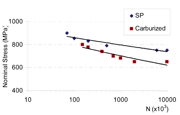
Figure 1

Figure 2

Figure 3
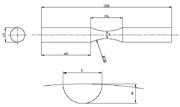
Figure 4
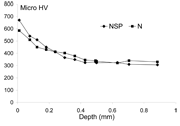
Figure 5 - Microhardness in-depth trend of the N and NSP specimens.
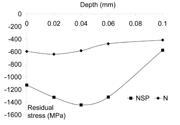
Figure 6 - Residual stress in-depth trend of the N and NSP specimens.
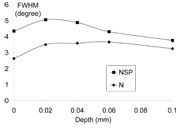
Figure 7 - FWHM in-depth trend of the N and NSP specimens.

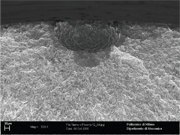
Figure 8

Table 1 - Results of the stair-case procedure (3E+06 cycles)
Unlike carburizing followed by shot peening, the compound treatment formed by nitriding plus shot peening has not yet been adequately investigated. In the present paper a review of some of the known results regarding the mechanical strength of components subjected to this treatment are presented together with some promising results obtained by the authors.
Introduction
The achievement of high performances, lightness and reliability of mechanical elements is often and strongly related to the application of some appropriate surface treatment.
If the attention is focused on fatigue and fatigue related damage processes, nitriding and shot peening are known as some of the most effective methods to increase the strength of components.
It is also well known that shot peening effect is more pronounced on surface hardened materials: among these latter the most widely used treatment before shot peening is carburizing (see, for example, [1-4])
Less investigated is the case of nitriding followed by shot peening: this is usually attributed to the fact that nitriding is able by itself to give adequate hardness and fatigue strength and also to the fact that, in high-cycle fatigue applications, cracks in nitrided elements start from an internal inclusion (at least without a strong notch effect), thus preventing to make really effective the residual stresses induced by shot peening.
To the authors’ knowledge there are few papers related to this topic and the knowledge about its real effect on fatigue properties is still limited. In this paper the studies found in literature about this compound treatment (nitrided+shot peening) are described. After that, some new and interesting results obtained by the authors concerning the fatigue strength of a nitrided and shot peening low-alloy steel are pointed out. These results show the potential positive action of shot peening after nitriding, encouraging further research in this field.
The strength of nitrided and shot peened steels under cyclic loads
Fatigue strength
It is well known that shot peening is applied in many different industrial sectors where lightness and high mechanical strength are primary requirements during the development of the design of new competitive products. Automotive and aerospace manufacturers, for example, widely use shot peening to increase the performances in many important components like gears, crankshafts and springs. In Figure 1 it is shown a S-N curve of specimens similar to spur gear teeth made of a carburized steel where the effect of shot peening is evident [5].
As mentioned in the previous paragraph, the effect of shot peening is more evident if this treatment is applied to hard surfaces: notwithstanding the previous consideration, the application of shot peening after nitriding is less considered and applied, maybe because of the fact that nitriding itself is less common than carburizing and also because nitriding causes the formation of a thin and very hard surface layer of material able to guarantee by itself adequate mechanical strength. The consequence is that the available data is relatively rare.
In [6] the authors refer to automotive parts and consider the application of shot peening after different heat treatments. Among these latter there is tufftriding, applied together with shot peening. The bending fatigue tests carried out by the authors show the ability of shot peening to increase the fatigue strength on tufftritrided elements, even if the effect is different by considering different materials: in Figure 2 the fatigue strength of a carbon steel (S45C) and of a Cr-V steel normalized or tufftrided or tufftrided and shot peened are compared. The improvement of the fatigue strength due to shot peening is evident.
A more recent paper about the application of shot peening after nitriding [7], considers the development of an approach, based on Design of Experiments, to select the peening parameters able to give the best results on previously nitrided elements. The material considered is the steel 32CrMoV13.
Contact fatigue strength
Concerning contact fatigue, a paper written by Jingpu [8] describes rolling contact fatigue tests conduced using ring specimens (diameter=50mm and contact width=4mm) made of 40Cr steel and previously subjected to a treatment composed by ion-nitriding, induction hardening and shot peening. The residual stress measurements show that ion-nitriding plus induction hardening give tensile values on the surface, while the application of shot peening induces strong compressive residual stresses (up to -1000 MPa) in a thin surface layer. The results of the contact fatigue tests show that the specimens subjected to shot peening have a longer endurance: in Figure 3 it is possible to observe that the fatigue life is increased by 5-8 times.
Experimental tests
If the previous results are considered, it is clear that a general wide approach to evaluate the fatigue strength of the nitrided and shot peened layer of material is still lacking. The following describes the development [9] of an approach based on Fracture Mechanics to evaluate the effect of shot peening on fatigue strength of nitrided elements with small defects.
Rotating bending fatigue tests were carried out on specimens including a micro-hole (with controlled geometry and dimension) acting as a pre-crack to determine the fatigue threshold value of the stress intensity factor (?Kth).
The material considered is the steel 42CrMo4 UNI EN 10083 (UTS=1100 MPa, Yield Strength=950 MPa, Elastic Modulus E=206?000 MPa, Elongation A=10%; chemical composition: C=0.4%, Mn=0.6%, Si=0.15%, Cr=1.1%, Mo=0.2%, P<0.035%, S<0.035%).
Sandglass specimens were used (see Fig. 4). In the minimum section of these specimens, a micro-hole acting like a pre-existent crack [10] was obtained by controlled electro-erosion, allowing to elaborate the results in terms of fracture mechanics concepts.
Two different series of 15 specimens were considered. The first series (N) includes specimens that were gas nitrided (temperature T=520°C, duration of gas nitriding = 50 h). The second one (NSP) is formed by specimens that were gas-nitrided (same parameters of series N) and then shot peened (Almen intensity=16A).
In Fig. 5 the micro HV in-depth trends are shown: shot peening influences the values just under the surface (less than 100?m in depth).
The sub-surface layer of material was characterized also by measuring the residual stresses by means of a AST XStress 3000 X-Ray diffractometer. In Fig. 6 it is possible to observe the measured trends of the longitudinal residual stresses for the three series of specimens: the strong change induced by shot peening is noted.
The X-ray diffraction measurements allowed researchers to obtain another piece of important information about the state of material: the full width at half the maximum diffraction (FWHM), related to the grain distortion and to the dislocation density [11], at the same time is related to the surface work hardening. In Fig. 7 the in-depth trend of FWHM is shown. The strong influence of shot peening also on this parameter until a depth of 0.3 mm is clear.
Fatigue threshold assessment
Rotating bending fatigue tests were carried out on the sandglass pre-cracked specimens, the aim being to assess their fatigue limit. For every series 15 specimens were considered.
The tests were stopped after 3E+06 cycles, and the specimens not broken after this number of cycles were considered run-out. The results were elaborated by using the stair-case procedure. In Table 1 it is possible to observe the final results of the fatigue tests: the improvement induced by shot peening is evident, able to double the fatigue limit of the pre-cracked specimens.
In Figure 8 it is possible to observe the fracture surface of a broken specimen together with an arrested crack of a run-out specimen (broken after the end of the test by using liquid nitrogen).
The results were also elaborated in terms of ?Kth, by considering the formula [10]:
Formula can not be printed on the web. Ask for PDF
where area is the area of the arrested crack and ??lim is the fatigue limit experimentally determined: the results obtained are ?Kth=14.2 MPa?m for the nitrided material and ?Kth =25.1 MPa?m for the nitrided and shot peened one.
This strong increment of the fatigue threshold due to shot peening was attributed to the residual stress field induced by shot peening and to the surface work hardening due to shot peening. A predictive formula including these two factors is proposed. It is based on the one developed by Murakami and considers the effect of the surface hardening due to shot peening as the ratio between the FWHM value before and after shot peening:
Formula can not be printed on the web. Ask for PDF.
where HV is the Vickers hardness, R?K=?Kmin/?Kmax and considers the effect of the residual stresses, ?=0.226 +HV?10-4 and the other symbols have the meaning previously defined.
If this formula is used, values of ?Kth close to the experimental ones are obtained for the shot peened material (?Kth=24.7 MPa?m). This formula can be used to assess the fatigue strength of nitrided and shot peened low alloy steels with small surface defects acting as preferential site for crack initiation.
Conclusions
The fatigue properties of steels subjected to nitriding and shot peening were investigated and the few data found in literature were critically assessed, evidencing the lack of a general analysis approach for this treatment.
The results of the research aimed at the determination of the fatigue threshold of nitrided and shot peened steel were presented and the strong influence of shot peening evidenced. The predictive formula proposed fits well with the experimental results and can be considered the basis for the development of a general design approach able to guide engineers toward a correct evaluation of the application of shot peening on nitrided steels containing small surface defects. Further investigations are needed to generalize the proposed approach: however, the results of on-progress tests seems to confirm the ability of the proposed approach in predicting the fatigue threshold of nitrided and shot peened steels.
References
1. Marsh K.J. (Ed.). Shot peening: techniques and applications. EMAS, 1993.
2. V. Schulze. Modern Mechanical Surface Treatment. Wiley-VCH, 2004.
3. M. Widmark, A. Melander: Int J Fatigue 21 (1999), 310-327.
4. M. Guagliano, M. Guidetti, E. Riva: Engineering Failure Analysis 9 (2002), 147-158.
5. A. Blarasin, M. Guagliano, L. Vergani: Fatighe Fract Eng Mater Struct 20 (1999),1171–1182.
6. M. Ohsawa, T. Yonemura T.: Proceedings of the IV International Conference on Shot Peening (1990), Chicago (USA), 147-158.
7. D. Croccolo, L. Cristofolini, M. Bandini, A. Freddi: Fatigue Fract Eng Mater Struct 25 (2002), 695-707.
8. Z. Jingpu: Proc. of the II International Conference on Shot Peening (1984), Chicago (USA), 215-224.
9. I. Fernández Pariente, M. Guagliano : Surface & Coatings Technology 202 (2008), 3072-3080.
10. Y. Murakami. Metal Fatigue: Effects of Small Defects and Nonmetallic Inclusions (Elsevier) (2002) 35-74.
11. I.C. Noyan, J.B. Cohen. Residual Stress- Measurement by Diffraction and Interpretation, Springer-Verlag, New York, 1987.
Inés Fernández Parientea
aDep.to Ciencia de los Materiales e Ingegneria Metallurgica, Universidad de Oviedo Campus de Viesques, edificio de Energía, Gijón (Spain)
E-mail: inesfp@uniovi.es
Mario Guaglianob
bDip.to di Meccanica – Politecnico di Milano, Via La Masa, 1 – 20156 Milano (Italy)
E-mail: mario.guagliano@polimi.it



























